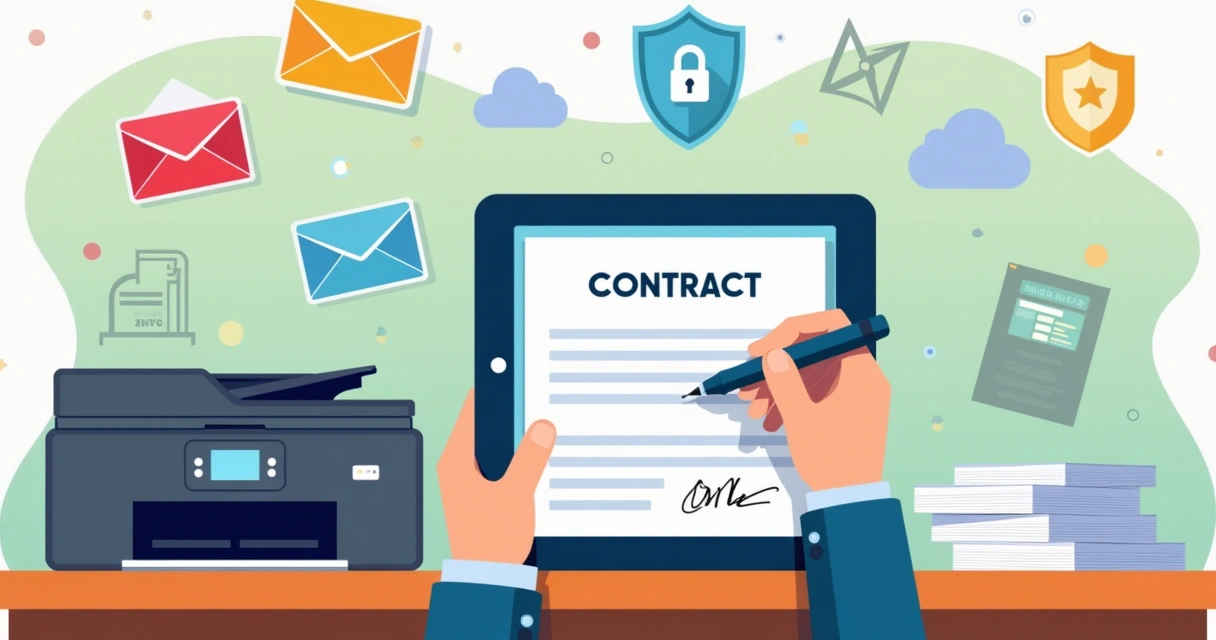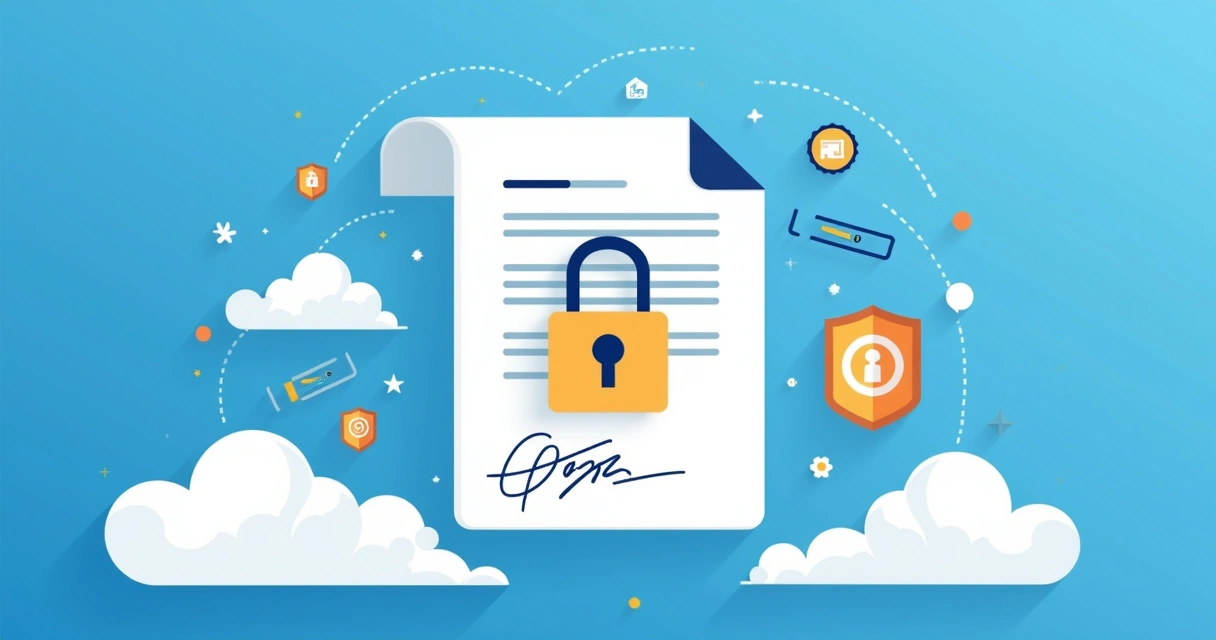Have you ever had a contract waiting for your signature while you were miles from your desk? Maybe you needed to sign quickly but the printer ran out of ink. Or perhaps you just wished for a faster solution that didn't involve searching for a pen? In our digital age, these problems are fading, replaced by a new question: What’s the quickest and safest way to sign documents online for free?
If you’re looking for a practical guide on how to start with free document signing, you’re in the right place. Let’s walk through the benefits, the process, and some key points often missed by first-timers.
Why many are choosing digital signatures
Think back a few years. Imagine stacks of forms, envelopes, and perhaps a mad rush to meet a post office deadline. That's how approvals and agreements once worked. Today, digital document signing has changed the game.
- Speed: Most documents can be signed, sent, and filed in the time it would take to print a single page.
- Security: Modern systems are armed with encryption and audit trails that make them far safer than a drawer full of paper contracts. eFax highlights how encryption and audit trails help protect digital signatures, surpassing traditional handwritten signatures.
- Legal validity: Few realize digital signatures aren’t just convenient; they’re legally binding across most of the world, including Ireland, thanks to the eIDAS regulation. According to Juro, electronic signatures have the same legal status as handwritten signatures in the European Union, including Ireland.
- Cost savings: No more printer ink, paper, or postage. PandaDoc reports savings up to 85% by shifting away from traditional document handling.
That’s not just theory, studies like Fujifilm’s review of digital signatures show that digital workflows shave approval cycles from days to minutes, especially for businesses needing rapid sign-offs.
CloudSign.ie was born from these needs, built to help businesses and individuals sign, manage, and protect their documents online with minimal effort and zero paperwork.

Understanding the main ways to sign documents online
When you start using free tools for document signing, there are a few choices for how your signature appears. Each is quick, and usually requires no technical skills.
- Draw your signature: Most platforms let you draw your signature using your mouse, your finger (on a touchscreen), or a stylus. It’s personal, and it looks similar to your handwritten one.
- Type your name: Sometimes, you just type in your name, and the system turns it into a script-style signature. It’s not as personal, but it’s fast and always legible.
- Upload an image: If you prefer, upload a scanned image of your real signature. This is handy if you want consistency with physical documents.
CloudSign.ie, for instance, includes all three methods, making sure you can choose the one that feels most natural. If you want a closer look at these options, the step-by-step guide on free electronic signature in Ireland helps break it down.
Is your signed document really secure?
Signing a document is one thing. Making sure nobody tampers with it afterwards, well, that’s another story. Security is the backbone of any reliable digital signature solution.
Encryption is used to scramble your document so only the right people can read it. When you apply a digital signature, sophisticated code locks the file, recording the signer's identity, the time, and even the device or browser used.
Add authentication steps (like email confirmation or SMS codes) plus a certificate of completion showing a full history of the signing process, and you have a system where even a minor change is tracked.
If you ever want to show a contract’s authenticity, an audit trail makes it almost impossible to falsify. Platforms such as CloudSign.ie invest in the latest encryption and authentication, lowering the risks far below those of a paper process.

Legal standing: more reliable than it sounds
Skeptical about digital contracts being legally valid? It’s understandable. However, laws such as the EU’s eIDAS regulation were written to clarify exactly this, digital signatures are enforceable and just as legitimate as their handwritten counterparts in the EU and Ireland. Juro gives a helpful summary of how e-signature laws have developed. Many other countries have similar rules, but always check if you’re unsure.
CloudSign.ie, for example, only uses secure signing that complies with these standards, ensuring every signed document is recognized in court or during audits. If you want a quick, everyday introduction, the beginner’s guide to electronic signatures covers what’s needed for valid signatures and what to watch out for.
Simple steps: how to sign a document online for free
Alright, it’s time for action. The process can vary a bit by platform, but here’s the common routine you’ll find with user-friendly services like CloudSign.ie:
- Sign up or log in: Create a free account. You rarely need to provide more than your name and email if you’re just receiving documents.
- Upload your document: Drag and drop your file (often PDF or Word) into the system.
- Select where to sign: You’ll usually be shown your document and can click where your signature is needed.
- Choose your signing method: Draw, type, or upload your signature.
- Send it or download: When you’re finished, you can either send the signed document directly to another party or download it for your own files.
- Receive confirmation: Most systems provide a digital certificate or email notification confirming everything has been completed.
Not only is this fast, but most plans, even free ones, let a single user send more than enough documents monthly for personal or small business use. For instance, CloudSign.ie allows up to 21 envelopes per month on its free tier, ideal for freelancers or startups.
Connecting with cloud, mobile, and automation
Modern document signing doesn’t have to stand alone. The leading platforms integrate with cloud storage (like Google Drive), messaging tools (Slack), and even Customer Relationship Management systems (CRMs). This means your contracts move as quickly as your business does.
Through Application Programming Interfaces (APIs), advanced users can even automate approval chains and archiving. That’s easy to set up on CloudSign.ie and, frankly, it’s rare to find with most free-tier products elsewhere.

Features that make everything easier
Most users want more than just a free signature solution. It's about smooth, hassle-free management.
- Templates: Prepare your most-used documents (like offer letters or NDAs) once and reuse them anytime.
- Automatic notifications: Get emails when documents are viewed or signed, no more guessing who’s read what.
- Tracking: Watch the status of each document as it makes its way from creation to completed contract.
- Mobile support: Sign or approve from any device, whether sitting at your desk, in a cafe, or on a train.
Corporate teams use these features for everything from sales contracts and HR documents to supplier agreements and project approvals. Freelancers find them handy for client proposals or invoices. CloudSign.ie, for example, blends all of these, and as explained in the overview of digital signature software for 2025, these tools remove barriers and save time.
Document management isn’t only about signatures. Automation and integration can turn slow, clunky processes into something fast, secure, and actually enjoyable.
Sign from anywhere, on any device, whenever you need.
Advanced security: digital certificates and authentication
The foundation of trust in digital signatures is a mix of security layers. Digital certificates prove the identity of the signer, while two-step authentication ensures only the right person can access each document. If you want to learn how these steps come together for foolproof document signing, there’s a simple guide to fast and secure document signing available.
Other providers, such as DocuSign or Dropbox Sign, offer secure digital signing, but CloudSign.ie goes further by layering on intelligent risk analysis, automatic contract reminders, and deep integrations, all without the limitations you often find elsewhere.
Saving more than just time and money
The best part? Digital document signing isn’t reserved for massive companies with big IT budgets. It’s just as useful for a remote worker in Galway as it is for a legal team in Dublin. Easy access, robust security, and clear legal standing combine to remove hurdles for everyone.
You might be a freelancer signing your latest gig agreement, a startup onboarding a new client, or a manager finalizing a supplier contract. The tools are here, the costs are low (or free), and the peace of mind, well, that may be the biggest benefit no one tells you about.
Conclusion
The move to free document sign platforms isn't just a trend. It’s a smarter, safer way to handle agreements, spend less, and act faster than ever. CloudSign.ie brings all of these benefits together, allowing you to sign and manage documents with confidence, wherever you are.
So, why not try it? Signing documents online is now accessible to everyone. Explore our free plan or browse more tips and examples on the CloudSign.ie blog. Your next agreement is only a few clicks away.
Frequently asked questions
What is free document signing online?
Free document signing online is a service that allows users to electronically sign digital documents through a website or app without cost. These platforms, like CloudSign.ie, let you add your signature, share documents, and track their status instantly, whether for work or personal use.
How do I electronically sign documents for free?
You usually create a free account on a trusted digital signing platform. Then you upload your document (PDF, Word, etc.), select how you want to sign (draw, type, or upload an image), and place your signature where needed. When finished, you can send or download the signed document. To see step-by-step instructions, check out the free guides on CloudSign.ie’s blog.
Is digital signing secure and legal?
Yes. Modern digital signing uses encryption, audit trails, and identity checks for strong security. Services that follow regulations such as eIDAS (in the EU and Ireland) offer digital signatures with full legal validity, just like handwritten ones. Juro’s summary on e-signature laws gives more legal details if you’re curious.
Where can I find free e-sign services?
Several reputable services offer free online signing, often with fair monthly limits. CloudSign.ie lets individuals send up to 21 envelopes per month completely free and is designed with Irish and EU legal standards in mind. Other options, such as DocuSign or PandaDoc, provide free plans but with tighter restrictions.
Are there limits to free document signing?
Yes, most free plans set limits on the number of documents you can send or sign per month. For instance, CloudSign.ie gives you 21 envelopes per month, which is usually more than enough for personal or small business needs. Check your provider’s policy, as some restrict features or integrations unless you upgrade.
